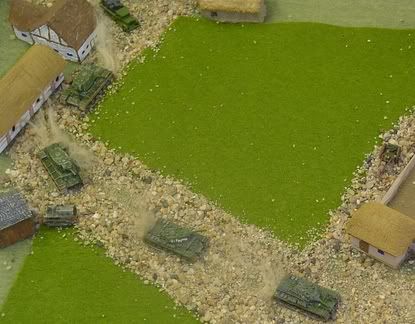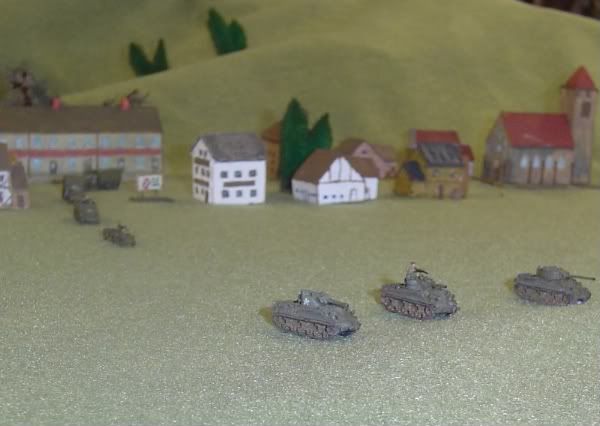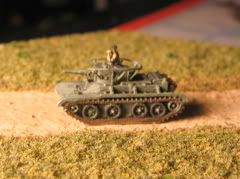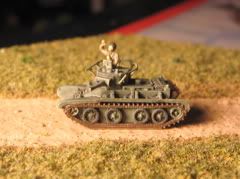I'm with av8r ... the first issue you need to determine is what you are identifying.
If you game at 1-to-1 unit scale (like me), there is very little to identify. I know that a particular tank is a T-34m43 just by looking at it. Don't need anything in writing to tell me that.
Do I need to know that a given tank is the second tank of the first platoon of company B of the 3rd battalion of the 433rd Medium Tank Regiment of the 29th Tank Corps? Nope. I don't. Not a bit of interest in knowing that as I'm off fighting my battle. I know it is a T-34m43. One of several (I hope).
About the only thing I need to know, more than what the vehicle is, is if it is a command tank. For the scale of my battles, platoon and company commands are the most important. I may also have a battalion command on some occasions, but as often as not there is only one battalion on the table for my side, and so the battalion CO units are pretty clearly identified just from the context.
So with this in mind, you can indeed consider how to identify your platoon and company command units.
I have tried several things in the past. I have often used a colored dot on the bottom of the tanks (red for platoon, yellow for company, white for battalion ... or some such). This is a very simple and useful technique. Gives no clue to your opponent, but does let you adjudicate the game with distinct impact if your CO gets knocked-out.
But the disadvantage is that you can easily loose track of which vehicle is the CO in the course of a turn. And so you wind up putting your CO in the wrong place in the formation, and he gets waxed!

I have also tried putting identifying marks right on the vehicles. Painting a color on the hatches, or putting a dot or strip on the back of the turret or the back of the engine deck. I have stopped that practice. I feel it reduces the visual appeal of the models too much. And it is too obvious to your opponent. And the CO gets waxed!

For my Soviets, one thing I have done is to put patriotic slogans on the sides of some tanks. These tanks can then be identified as command vehicles. This practics makes them quite easy for me to spot and keep track of, but does not instantly tip my hand to opponents.

Here a KV-1 serves as company CO, with a patriotic slogan on the turret side to ID him for me.
You can do the same with stars (or other national markings) on US or other nations' tanks. Just some eye-pleasing distinguishing mark. This approach is also quite flexible, because you don't always have to use the marks to ID COs. So you can keep "regular" opponents off-guard.
Another way to tell is just to mix model sub-varients. This is particularly easy with T-34s. You get a mix of models in each GHQ purchase. Just decide that some particular sub-model marks a CO's tank. With T-34m43s, the few that have cupolas serve nicely.
Others here have shown examples of more creative ways to identify CO tanks. I was particularly impressed by an example of BTs where the CO tanks had frame antenna and commander figures half-out of open hatches. I have done a couple models with open-hatches and commanders, but had never thought to use them to designate COs until I saw it here. I very much like the appearance, though. Think it is a spanking-good idea!


Here is an example of one of my open-hatch models. I put figures in the hatches of some of my Shermans, but I used them to help me spot the Sherman 105s rather than to identify the COs. But the effect is much the same. Oh, and BTW the Sherman with the white star is the CO.

For my tank destroyers I decided, based on what I saw here, to try using CO figures. But in this case it is somewhat more subtle. Each platoon of TDs in the ETO had 2 M20 utility cars. One was used as a command vehicle by the platoon CO, the other was used as a scout. So I have placed a standing figure with binocs in the CO scout cars, and an MG gunner in the other. I use the standing figures to identify the CO element.
You might also consider just adding the antenna to the COs tank. I don't do a lot of antennae, as I have managed to loose too many over the years. But some of the guys here do a credible job affixing them securely, and assert that they are pretty robust as a result.
Or you can come up with your own approach, and then tell us! Oh, and take a picture or two as well. We'd love to see!











